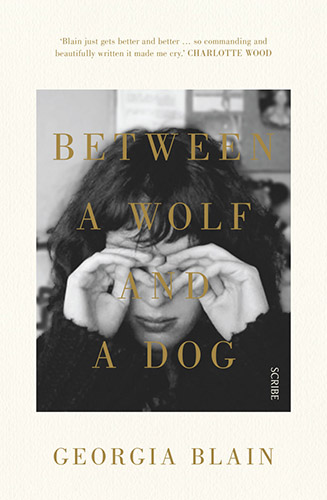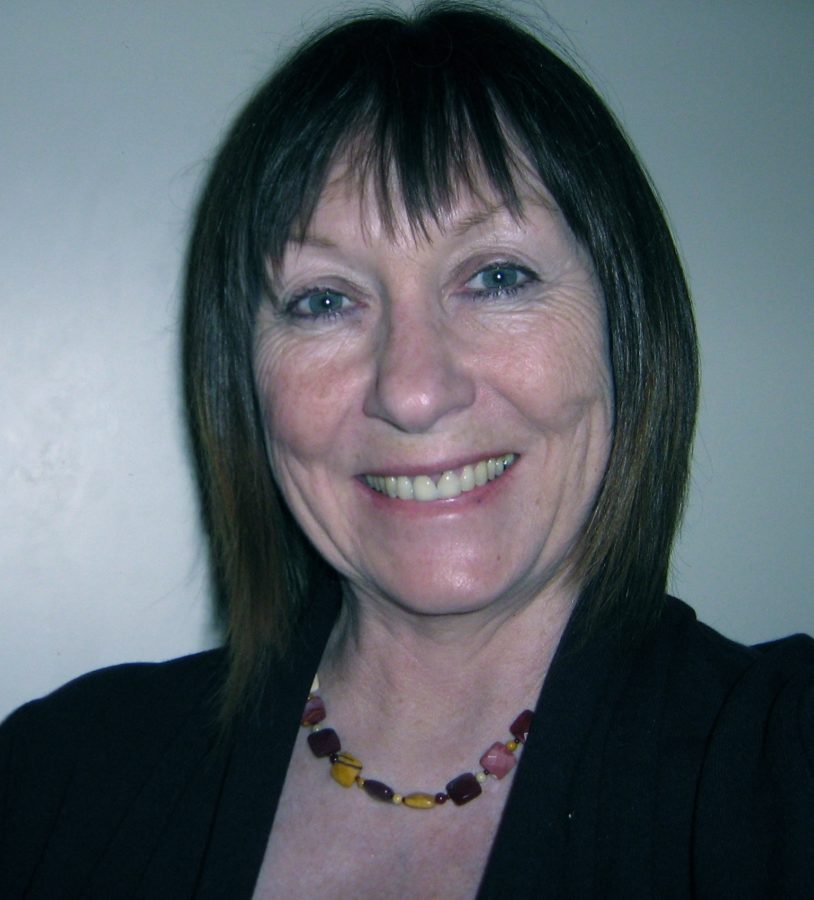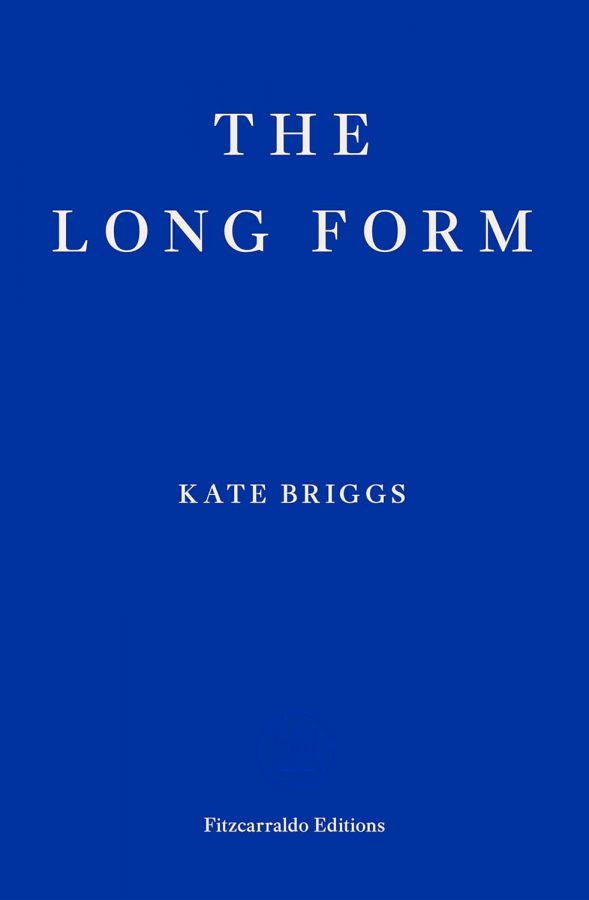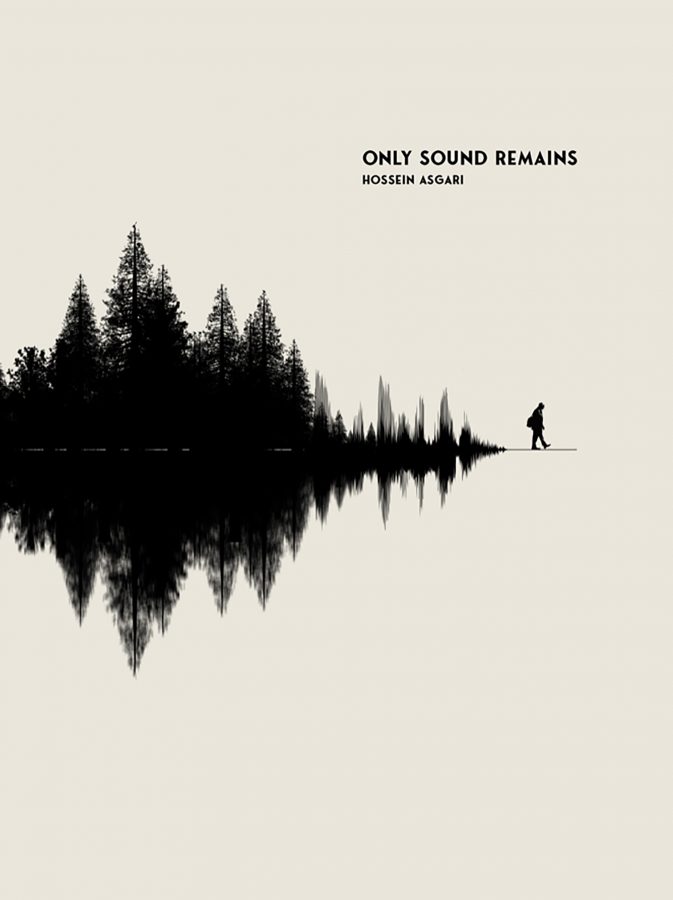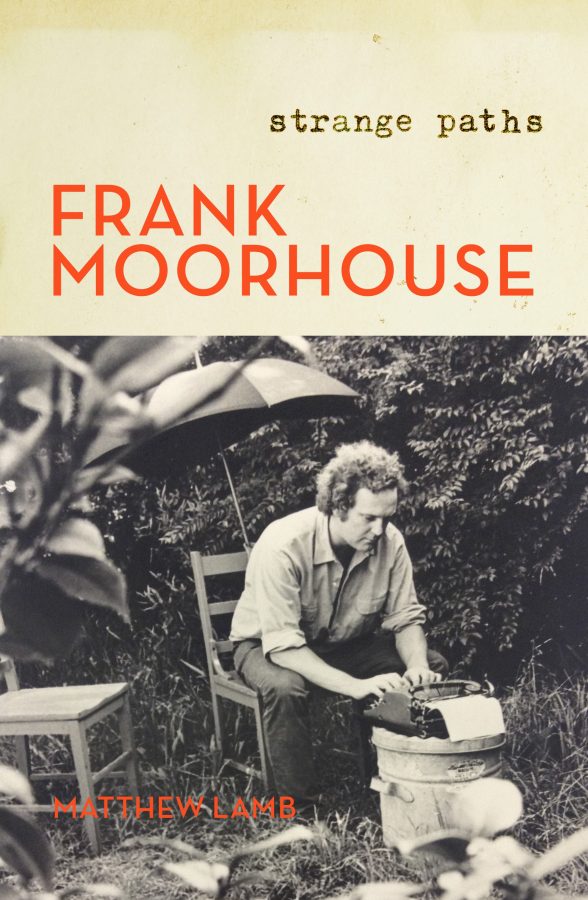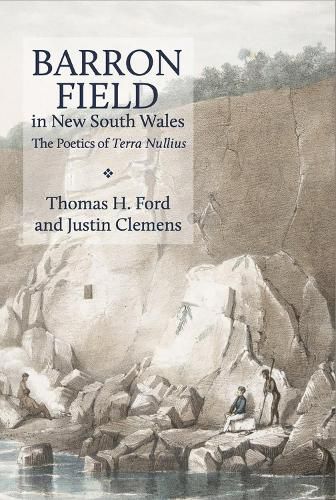Early in November 2015, Sydney novelist Georgia Blain had a seizure and was taken to hospital for tests. The results were as bad as they could be: glioblastoma, an aggressive and incurable brain tumour. Six days later she had surgery to remove the tumour – ‘the unwelcome guest’, her surgeon called it – but was warned that it would grow back. The prognosis with glioblastoma is always poor: without treatment, the average survival period from the time of diagnosis is three months. With treatment, a year or a little more. Blain died on 9 December 2016, thirteen months after diagnosis and a few days short of her 52nd birthday.
Her novel Between a Wolf and a Dog, years in the writing, was finished in manuscript and she was working on the edits when the cancer was diagnosed. In March 2016, shortly before its publication, Blain’s friend and fellow novelist Charlotte Wood interviewed her about the book, describing what she calls ‘a surreal irony in her work’:
As the novel opens, a central character – Hilary – reveals to the reader but not her children that she has cancer, and that it has spread to her brain. Hilary is contemplating whether to end her own life before the disease does.
‘When I went back to the copy edits [said Blain] I thought “Oh God, am I going to feel differently about this book, now that I’m in Hilary’s shoes?” … The good thing was I didn’t feel differently about the novel, but nor did I feel the same way the character does about her situation.’
It was a chilling convergence. After Blain died, Wood wrote a tribute to her friend in which she recalled the recording of this interview and its purpose:
Soon after her diagnosis I interviewed her about Between a Wolf and a Dog … I wanted to ensure public discussion of her work didn’t cast our majestic, talented friend as Poor Cancer Woman. She was a writer first, was still working, must keep going for as long as she wanted.
There are two kinds of potential conflation of book with author going on here. Wood is at pains, rightly, to disentangle Blain’s personal and bodily state from the achievement of her book and of the work she still had in progress. (Before she died, Blain finished her last novel, The Museum of Words, to be published by Scribe in August.) But there is also the way that life mockingly imitated art, as Wood points out: ‘The dreadful irony – that she had written a novel about a woman with brain cancer contemplating the end, while her own tumour was imminent but undiagnosed – is now well known.’
And the intertwining of author with book points to something that, while it has become more overt and perhaps even ubiquitous in these days of writers’ festivals (a comparatively new phenomenon) and social media (even newer), has been around for a very long time: the culture of celebrity that can engulf writers, and the eagerness with which readers persistently conflate writers with their writing. As I write this essay, for example, the other thing I have been doing this morning is reading Kathryn Hughes’ 1998 biography of George Eliot, in which Hughes reports that by the late 1860s, when Eliot was a famous and revered author with several monumental novels behind her, she was being inundated by letters from readers who thought they had detected in the calm, wise narrative voice of her novels a woman who might give them personal help. ‘… she was regularly besieged in letter and in person by men and women from around the world who were convinced that she, and she alone, could understand their story.’
By the time Between a Wolf and a Dog was published, Blain’s condition was widely known. It was difficult to read the book through any lens other than a sympathetic awareness of the situation’s terrible irony, and almost impossible, though most reviewers at the time tried honourably hard, to read the book purely as a work of fiction on its own terms, something separate from the fate of its author. Now, more than a year after the publication of Between a Wolf and a Dog and several months after the death of Georgia Blain, it’s possible to get at least a little distance between the two.
The first time I read Between a Wolf and a Dog, I read it purely for pleasure, for the story, in a holiday-house or reading-group kind of way. The second time around, now in ‘critic’ mode, I had slowed down and was reading for, and seeing, different things. There’s the precise crafting of the narrative, beginning and ending with a flawed character who redeems himself at the end, and proceeding from one main character’s point of view to the next in ways that make the interlocking of their lives steadily clearer to the reader. There’s the way that the separate crises in the characters’ individual lives are made to shed light on all the others. There’s the page in the appointments diary belonging to one character, a family therapist, whose working day shows the various common yet terrible ways in which couples and families can come to grief.
And above all, there is the rain. With a few exceptions, the events of the story occur over the course of one day, in one place: this is Sydney, and on this day, it rains all day.
It is only plants that gain any true beauty in this weather, she thinks. A grevillea is jewelled with rain drops, silver pearls clinging to the trembling tips of the flowers and the fine ends of the spiky fronds; a passionfruit vine gathers clusters of rainwater in the open hold of its leaves, shaking them out in a shower with each whisper of breeze.
The world is a place of wonder.
The rain intrudes constantly on everyone’s consciousness and comfort; it has sentience, and moods; it is gentle and vengeful by turns. By about halfway through the book, the reader begins to feel that the day is both crying and washing everyone clean.
There are four main characters. Hilary at seventy is a filmmaker, the widow of a successful visual artist and mother of two adult daughters. These two, April and Ester, have been estranged for three years, ever since Ester’s ex-husband Lawrence, the fourth in this quartet, had an ill-judged fling with April. Hilary has been diagnosed with a brain tumour she knows will kill her, and has decided to die on her own terms but has told no-one yet except a friend whom she knows will help her. Ester, a family therapist, bucks the stereotype of the younger daughter: she is the careful, serious one with the proper job. April is a musician and Lawrence a political pollster, both of them charming and flaky, both clever yet irresponsible, skimming across the surface tension of their lives. Lawrence, frustrated by the state of Australian politics (‘He hates this government – they appal him’), has fudged some figures and has just been caught out; he spends most of the novel looking over the cliff of professional ruin.
The minor characters are likewise precisely drawn and clearly differentiated, except for Ester and Lawrence’s twin girls, who enjoy confusing the adults by pretending to be each other. Hilary’s late husband Maurie, a successful artist whose reputation continues to grow after his death, is a generous and optimistic figure, remembered by his wife and daughters with love, but even Maurie – the most positive character in the book, if only in the memory of his family – has his faults. Ester’s tentative new love interest Steven seems a likewise positive character, intelligent and gentle. But the most interesting minor characters are Ester’s clients, who provide little windows for Blain to expand her ideas, attending their therapy appointments in scenes that also add to the reader’s sense of the structure of the day and the passing of time. These are people in varying kinds and degrees of pain, some of whose dilemmas proceed from their own behaviour, others reeling from some wild blow of fate, and none of them able to understand their own condition. One of the best scenes in the book is a scarifying therapy session with a couple at the end of their relationship (‘I don’t love you. I don’t fucking love you’): a bitter, inarticulate, withholding man and a noisy, messy, oblivious woman whom Ester has admitted to herself that she actively dislikes, a reaction she must suppress. This scene alone is a brief masterclass in the art of characterisation.
The novel’s title is the translation of the French expression l’heure entre chien et loup, ‘the hour between dog and wolf’. It refers to twilight, the dusky hour when you can no longer see clearly and might easily mistake a dog for a wolf or vice versa. Between a wolf and a dog: the uncertain space between faithful companion and savage predator, between civilisation and wildness, darkness and light, the known and the unknown, life and death. And on the day that most of the action in this novel takes place, every main character is in such a liminal zone, a place of flux and cusp, moving through a scary transition from one state to the next. April is about to act on her desire for reconciliation with her sister, which might only result in more conflict; Ester is about to embark on a new love affair, which might end in tears; Lawrence is facing the truth about the loss of his job and the risks of rejecting any attempt at evasion or lies. And Hilary, of course, is in that frightening zone where Georgia Blain, having written about it so convincingly, later found herself: the place where you are still alive but know that you will die, and soon.
The novel presents a surface of realism, a mode one might expect to be untidy in the same manner as real life, but underneath that surface lies a meticulously crafted structure. The book does not adhere quite faithfully to Aristotle’s three unities – of action, time, and place – but nor does it stray far from them. There is one main storyline: the terrifyingly straight journey that Hilary is taking towards death, to which all the other narratives are related. There is one main setting: the city of Sydney, which the characters leave only on their various journeys to the holiday shack on the river. And most of the action takes place on a single day, bracketed by brief chapters set the night before and the day after, and including the various tributaries of back-story that have all been flowing towards this moment.
The narrative point of view shifts from one character to the next, with each in turn seen living and thinking through his or her day; these transitions often turn on some commonality of experience or thought, or some logical progression from word-association. In the first chapter Lawrence wakes out of a dismal and disturbing dream in the small hours; in the second, it is his ex-wife Ester who wakes before dawn, at what is apparently the same time of the same night. At the end of one chapter, Hilary closes her eyes in a kind of rapture at the beauty of a summer flower; at the beginning of the next, Lawrence closes his eyes in an attempted find the peace promised by meditation. Other transitions from one character’s point of view to the next are achieved with a kind of ‘Meanwhile, in another part of the forest…’ technique: many of the novel’s short chapters begin with such phrases as ‘Across town’ or ‘Back in the city’. Such frequent shifts in point of view and changes of location might engender an effect of choppiness were it not for the smooth and cinematic way that so many scenes are verbally dissolved into the next.
Blain makes use of some simple but powerful symbols: the holiday shack, the rain, the river. And woven all through the story, like a recurrent motif in the pattern of a Persian rug, there is the refrain of changing light: dawn, dusk, midday, absolute night. ‘The light that cut between blanket and window was soft, pearly.’ ‘She leans forward and switches off the lamp, the darkness of the day seeping in now.’ ‘Lawrence looked down to where the lights were on in the house, glad there would be company, and he drove through, the bumper scraping over the gate, the darkness now surrounding him, all last remnants of the day swallowed by the night.’
One of the consistent criticisms of her fiction over the years, Blain has said, is that ‘I talk too much about the privileged middle class.’ This would be a valid criticism if her writing were implicitly (much less explicitly) approving and reinforcing of all middle-class values, especially among readers for whom the very phrase ‘middle class’ is a term of abuse. But there is a substantial amount of implicit class critique in this novel, and three of the four main characters are artists whose work and vocations put them at the margins of class analysis in any case. Besides, the chronicling of the middle class, the exploration of its articulate strivings and failings, is a task to which the novel form is particularly suited, as many a literary historian has pointed out. Nor does or should a good novel work only on the literal level of representation, or of interpretation, and this book explores many of the big abstract themes that go to the heart of society at any level: power, integrity, conflict, freedom. And as Helen Garner once said, long ago and rightly, ‘a writer should at the very least be granted her material, and her subject matter.’
Charlotte Wood has written that the novel covers ‘Blain’s familiar terrain: the ordinary sadnesses in families, betrayal and forgiveness, the small, potent beauties of daily life that we allow to slip unnoticed through our fingers.’ And that is true. But this is also a book about working life, about where each adult character fits – or doesn’t fit – in the machinery of public life, be it social, cultural or political; every character’s job or profession or vocation is an intrinsic part of her or his life, and much of the book is devoted to exploration of this. Hilary is a highly regarded filmmaker, gifted and driven. April has had one substantial success as a songwriter but has since struggled to find inspiration and produce good work. Ester meets her promising new love interest at a work-related event, part of their professional development as counsellors and advisers. Ester’s work in particular provides a formal framework for the passing of a single day: in the opening page of the novel, we see her appointments diary. This both carves up the coming day into parcels of time and signposts some of the things that the novel will be about.
Ester’s appointment diary is open.
9.30am: Louisa
11.00am: The Harcourts
1.00pm: Daniel and Sarah
2.15pm: Chris
4.00pm: HannahIn her head she sees the structure of her day: post-natal depression, school aversion, relationship crisis, death and loneliness. Lawrence used to call her diary the Happiness Book.
And the scenes in which Lawrence faces the prospect of imminent professional disgrace, like the scenes in which Ester deals with her clients, go to the heart of what professional life means for the inner self, and how closely working life and private life are intertwined:
He had never envisaged his life here. Middle-aged, divorced, unhappy with his work. It is a cliché of which he is ashamed … Ester used to encourage him to quit. She’d make suggestions – politics, journalism, policy research – all of which he’d dismiss. Eventually, she gave up. What would she tell him to do now, he wonders, and he can see her, horrified by the mess he has found himself in, and then not surprised, because this is what Lawrence does: he lies, he cheats, and he fucks up.
This is as far as it could be from Hilary’s intense, inspired, and independent working life, work that she performs as a vocation, existing seamlessly as part of an integrated life:
Like all her work, it is made from fragments – old pictures, images from Maurie’s notebooks, archive footage, and film she has shot over the years. She works in collage, layering images on top of each other in order to untangle larger ideas about life.
Between a Wolf and a Dog has done well so far in the current literary-awards calendar, shortlisted for the Stella Prize and for the Australian Literature Society’s Gold Medal, winner of the fiction section in both the Queensland Literary Awards and the Victorian Premier’s Literary Awards. The latter prize was accepted on the presentation night, a matter of weeks after Blain’s death, by her partner Andrew Taylor. ‘It’s great that she won, but it’s sad and cruel that she can’t be here,’ he said. ‘She would have been honoured and thrilled.’
As though she thought she might not have enough to do in what she knew would probably be the last year of her life, what with editing the current book, writing the new book, enduring the chemotherapy and radiotherapy, and spending time with her family and her friends, Blain undertook to write a monthly column for the Saturday Paper, called ‘The Unwelcome Guest’, about living with her condition and facing the end of her life. She managed eight of these altogether, from January to July 2016 and then one final column in October, which began ‘Two months after stopping chemotherapy, my tumour has grown back.’ These columns are clear-eyed, thoughtful and unflinching explorations of her experiences as a cancer patient: thoughts on voluntary euthanasia, on meditation, on medical testing, and on the inexpressible comforts of a loving partnership.
After her death, at least four friends and fellow-writers published heartfelt farewell pieces recalling her talent, her humour, her strength and her friendship: obituary tributes from Charlotte Wood, Sophie Cunningham, James Bradley and Jane Gleeson-White all gave readers some personal glimpses of the woman behind the books. The final word belongs to Wood, whose appraisal of those final columns about the Unwelcome Guest applies broadly to the work of Georgia Blain: ‘Her deepest scrutiny is of herself but as with all the best writing turns outward, speaking of broader things.’
References:
Candida Baker, ‘Helen Garner’, in Yacker (Picador, 1986)
Georgia Blain, ‘Choose Control’, The Saturday Paper, 8 October 2016
Kathryn Hughes, George Eliot: The Last Victorian (Fourth Estate, 1998)
Jason Steger, ‘Victorian Premier’s Literary Awards 2017 winners: Georgia Blain wins posthumous prize’, Sydney Morning Herald, 31 January 2017
Charlotte Wood, ‘Georgia Blain: How she is coping with two new books and a battle against cancer’, Sydney Morning Herald (online), 18 March 2016
Charlotte Wood, ‘Pure Truth’, The Saturday Paper, 24 December 2016
